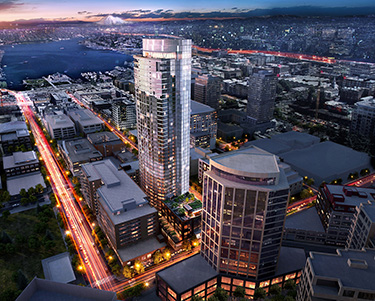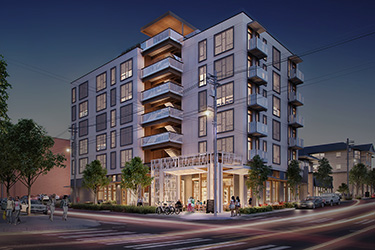|
Subscribe / Renew |
|
|
Contact Us |
|
| ► Subscribe to our Free Weekly Newsletter | |
| home | Welcome, sign in or click here to subscribe. | login |
Construction
| |
 |
October 26, 2017
High-performance building? Start with early design analysis
ArchEcology

Luddy
|
Early design analysis. Integrated process. Holistic building design. There are many names, but they all point to the same idea: Let’s get all the design team players around the table early and brainstorm optimal ideas for the project before too many decisions have been set in stone.
It’s certainly not a new idea, but rarely executed in practice. Who has the time? It’s just an extra expense, right?
Not necessarily. As more and more emphasis is put on high-performance buildings, it’s not only beneficial but absolutely critical to set project strategy with early design analysis (EDA).
How it should work
EDA can take many forms, but the core concept is to analyze total building performance at the outset. Typically this includes preliminary energy modeling (a “shoebox” model), site feature analysis (such as daylight and water management) and a set of meetings between all major design team members to evaluate results, coordinate responsibilities and establish design targets.
EDA is an opportune time for team members to brainstorm on anticipated challenges and suggest out-of-the-box solutions before the pressures of schedule and budget set in. By doing the legwork early, time, effort and costs all get saved later in the design process since high performance is baked into the design from the beginning.
Tough get tougher
By now almost everyone has had some experience conforming to the 2015 Washington state and Seattle energy codes. There are many new requirements to juggle, such as dedicated outdoor air systems, tighter air leakage rates and lower lighting power densities.
What’s the best compliance path for a specific project? Is the design hampered by one or two very specific code requirements? These are perfect questions to explore during EDA.
In our experience, the preliminary energy model can signal a means of compliance that avoids onerous prescriptive requirements that may not make sense for a particular project.
Above and beyond
Code may be mandatory, but more projects are also attempting to push efficiency with certifications such as LEED V4, Passive House and the Living Building Challenge. These ambitious goals have to be established from the start. EDA can lay out a pathway to aggressive targets for energy reduction, as well as water usage and treatment. EDA can also identify benefits of the site conditions that can be used to the project’s advantage, such as shading from surrounding land features.
Indeed, goals that may seem insurmountable at first, such as net zero energy, may be more feasible than expected once everything has been analyzed together.
Breaking down ‘silos’
Early design analysis also pushes a level of coordination at the start of the project that breaks the different “silos” inhabited by architects, engineers and contractors. With ambitious performance goals, it is critical to get early commitment from consultants and subs.
Perhaps your project is relying on high-efficiency HVAC equipment and lighting to meet energy code targets and reduce your EUI (energy use intensity). Do the mechanical and electrical engineers know that? Was that included in their fee from the beginning?
EDA pushes those discussions to the forefront, giving everyone a better idea of what to expect.
Expanded toolbox
One significant reason why more analysis can be done early is the industry-wide adoption of BIM software. Some packages, such as Revit, bundle analysis tools to study energy use, daylight penetration, solar shading, etc. Additionally, many stand-alone analysis tools offer means of importing Sketchup or Rhino models to speed up and simplify the process.
These tools give design teams the ability to run quick and dirty analysis of building characteristics and systems fast enough to help drive the early concept. The team can evaluate the impact of various options for lighting, power and HVAC long before those systems are typically designed, which in turn can help inform ideas for layout and programming.
Just be careful! It’s one thing to have these tools at your fingertips, but it’s essential that the person conducting the analysis, whether an in-house expert or outside consultant, understands how to interpret and apply the results that come from the data.
Make it effective
Just like any other tool, early design analysis is only as useful as you make it. Ideally the discussions should involve the full design team: owner, architect, MEP designers, landscape architect, civil engineer and general contractor.
In a design-build environment not all the players are on the project in early phases. However, it pays to bring these team members in, even for a few hours of discussion, to get the full perspective on practicality and constructability of various concepts. Sometimes the best ideas for saving energy come from the GC, or the electrical engineer remembers another project with an innovative water management feature that would be just perfect here.
Not only is it beneficial to get diverse perspectives, but collaborating gives all team members a sense of responsibility towards achieving performance goals. By allowing an open environment where no idea is too ridiculous or easily dismissive, the design team can foster creativity and be more engaged in the design process. It should be fun as well as informative!
Cost vs. benefit
No way around it, there are soft costs associated with the early design analysis process. However, it can streamline future design phases and prevent costly mistakes. As energy code and sustainability requirements grow more challenging, the industry has to get past the idea of “let’s just build it like the last one.”
If the project is going to be high performance, if the design team is going to aspire to meet more challenging targets, then we had better think through all the possibilities to make high-minded goals a reality.
Daniel Luddy, PE, BEMP, CPHC, LEED AP, is a senior energy engineer with ArchEcology, a Seattle-based sustainability and energy consulting firm.
Other Stories:
- Ice Box Challenge: a cool test of Passive House
- Survey: Code Unlimited
- Survey: IA Interior Architects
- Surveys: NAC Architecture
- Survey: AHBL
- Survey: Lemons Architecture
- Is growth only benefiting a small segment in Seattle?
- Rock wool’s new role: protecting exterior wood stud walls
- Get ready for the new year — and new energy codes
- After 10-year engagement, Kinects inverts ‘wedding cake’
- WSU cultural center: ‘How are you going to build this?’
- How ‘affordable’ housing is disappearing in Seattle
- How long will your AV last? Consider your cell phone
- Survey: Arup




